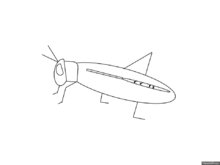


Hemolymph, or haemolymph, is a fluid, analogous to the blood in vertebrates, that circulates in the interior of the arthropod (invertebrate) body, remaining in direct contact with the animal's tissues. It is composed of a fluid plasma in which hemolymph cells called hemocytes are suspended. In addition to hemocytes, the plasma also contains many chemicals. It is the major tissue type of the open circulatory system characteristic of arthropods (for example, arachnids, crustaceans and insects).[1][2] In addition, some non-arthropods such as mollusks possess a hemolymphatic circulatory system.
Oxygen-transport systems were long thought unnecessary in insects, but ancestral and functional hemocyanin has been found in the hemolymph.[3] Insect "blood" generally does not carry hemoglobin, although hemoglobin may be present in the tracheal system instead and play some role in respiration.[4]
- ^ Chapman 1998, p. [page needed].
- ^ Wyatt, G. R. (1961). "The Biochemistry of Insect Hemolymph". Annual Review of Entomology. 6: 75–102. doi:10.1146/annurev.en.06.010161.000451. S2CID 218693.
- ^ Hagner-Holler, Silke; Schoen, Axel; Erker, Wolfgang; Marden, James H.; Rupprecht, Rainer; Decker, Heinz; Burmester, Thorsten (2004-01-20). "A respiratory hemocyanin from an insect". Proceedings of the National Academy of Sciences. 101 (3): 871–874. Bibcode:2004PNAS..101..871H. doi:10.1073/pnas.0305872101. ISSN 0027-8424. PMC 321773. PMID 14715904.
- ^ Hankeln, Thomas; Jaenicke, Viviane; Kiger, Laurent; Dewilde, Sylvia; Ungerechts, Guy; Schmidt, Marc; Urban, Joachim; Marden, Michael C.; Moens, Luc; Burmester, Thorsten (2002-06-04). "Characterization ofDrosophilaHemoglobin". Journal of Biological Chemistry. 277 (32): 29012–29017. doi:10.1074/jbc.m204009200. ISSN 0021-9258. PMID 12048208.